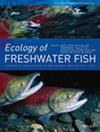Isotopic Niche Size and Niche Overlap of Yellow Perch (Perca flavescens) Reflect Trophic Position and Dissolved Oxygen Patterns in Lakes
Abstract
Understanding patterns of trophic niche overlap in fish communities is important because trophic redundancy can stabilise food webs. δ13C and δ15N in fish can be converted into percent littoral carbon and trophic position, respectively, and subsequently used to estimate isotopic niche size and overlap between species. We hypothesised yellow perch (Perca flavescens) would have the most niche overlap on other species due to their central position in lake food webs and large ontogenetic changes in diet. We also hypothesised variance in niche overlap across lakes would be driven by variance in size structure of perch populations among lakes. Alternatively, variance in perch niche overlap could be driven by food web variables such as mean trophic position. We addressed these questions by sampling fish in 17 Minnesota (USA) lakes. Results showed mean perch niche overlap on other species was significantly larger than all other species, and that perch niche size was positively related to niche overlap. We subsequently found no evidence perch population length structure influenced niche size or overlap, as no metrics of perch size structure were related to either variable. Instead, perch mean trophic position was negatively related to perch niche overlap and marginally related to niche size. Perch mean trophic position, in turn, was positively related to depth of hypoxic water. Our results indicate yellow perch may be important for stabilising lake food webs through high trophic redundancy on other fish species and that the degree of trophic redundancy may be influenced by dissolved oxygen patterns in lakes.

 求助内容:
求助内容: 应助结果提醒方式:
应助结果提醒方式:


